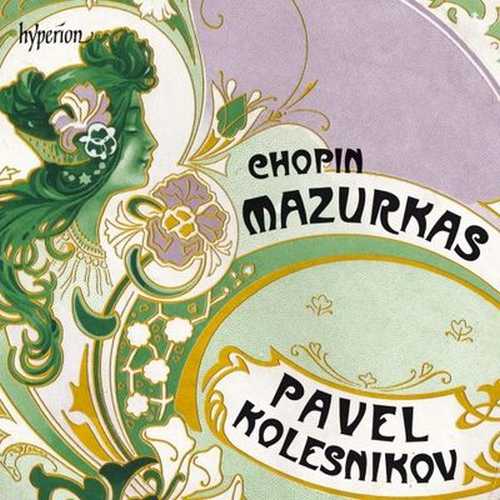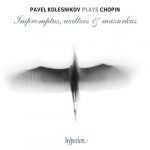
Composer: Frédéric Chopin
Performer: Pavel Kolesnikov
Audio CD
Number of Discs: 1
Format: FLAC (tracks)
Label: Hyperion
Release: 2016
Size: 1.1 GB
Recovery: +3%
Scan: yes
01. Mazurka in A♭ major, Op. 50, No. 2
02. Mazurka in C major, Op. 56, No. 2
03. Mazurka in E minor, Op. 17, No. 2
04. Mazurka in A♭ major, Op. 17, No. 3
05. Mazurka in F♯ minor, Op. 59, No. 3
06. Mazurka in G♯ minor, Op. 33, No. 1
07. Mazurka in A minor, Op. 68, No. 2
08. Mazurka in G minor, Op. 24, No. 1
09. Mazurka in A minor, Op. 17, No. 4
10. Mazurka in B♭ minor, Op. 24, No. 4
11. Mazurka in B♭ major, KKIIa/3
12. Mazurka in B♭ major, Op. 17, No. 1
13. Mazurka in C major, Op. 33, No. 3
14. Mazurka in A♭ major, Op. 24, No. 3
15. Mazurka in E minor, Op. 41, No. 1
16. Mazurka in B minor, Op. 30, No. 2
17. Mazurka in C♯ minor, Op. 50, No. 3
18. Mazurka in C major, Op. 24, No. 2
19. Mazurka in A minor, KKIIb/5
20. Mazurka in F♯ minor, Op. 6, No. 1
21. Mazurka in A minor, KKIIb/4
22. Mazurka in G major, Op. 50, No. 1
23. Mazurka in C minor, Op. 56, No. 3
24. Mazurka in A♭ major, Op. 59, No. 2
Chopin’s mazurkas have the reputation of being connoisseurs’ music, an acquired taste for sophisticates. But there is no particular reason why this should be so, since their charms and profundities reveal themselves just as directly as is the case for his apparently more ‘accessible’ genres like the nocturnes or ballades. Doubtless the misconceptions that surround Chopin’s mazurkas have to do with their evident ‘exoticism’, for listeners are commonly informed that the genre arose directly from the Polish people, that it blended characteristics of three distinct triple-metre folk dances (the mazur, the oberek and the kujawiak) in order to reveal something essential about the Polish music soul.
But these are essentialist myths. Chopin did not approach the mazurka as a kind of ethnographer. Though as a youth he did come across some mazurkas played by country folk, his knowledge of the genre was largely informed by urban dance culture: any city-dwelling Pole in the first third of the nineteenth century would have encountered danced mazurkas in all manner of social settings. Published scores of these danced mazurkas reveal simple, diatonic works, which gives the lie to the notion that the complexities of Chopin’s mazurkas somehow reflect their exotic Polish origins. Chopin in his mazurkas did not imitate a Polish sound; he created this sound. That Chopin invented a musical image of Poland is an idea altogether more impressive than any portrayal of him as a dutiful stenographer of a putative folk original.Chopin’s mazurkas were by no means the first such works published for piano, but they were the first to offer up to a wider European audience an imaginary recreation of the idea of Poland in sound. The mazurka in F sharp minor, Op 6 No 1, opened the very first set of mazurkas that Chopin published (in 1833), and it wonderfully encapsulates the novelty of this new musical landscape. Its very first bars no sooner establish the home key of F sharp minor than the music slips sinuously away from and then back to this key via a chromatic sequence. Deliciously unstable harmonies of this sort would continue to feature prominently in Chopin’s sound evocation of Poland. And when the opening phrase returns, Chopin marks it ‘rubato’, thus introducing another crucial quality of this musical place: the idea of rhythmic dislocation, of the flexibility invited from the pianist in the rendering of the durations of notes, would continue to figure centrally in the genre, whether Chopin notated it explicitly or not (he stopped marking the word in his scores after 1835). And another key marker for the genre is its three-part design, with a central contrasting section setting apart statements of the principal theme.
Chopin typically published his mazurkas in groups of three or four: this recording includes three such complete sets. With the four mazurkas, Op 17 (published in 1834), Chopin established a general pattern in which the concluding number of the set is usually the most lengthy and complex of the group. This pattern suggests a certain planning on Chopin’s part to ensure a kind of overall sense when an opus would be performed as a group. (Chopin did not insist that the mazurkas be presented in this way; indeed, he more often played individual pieces selected from different opuses, as Pavel Kolesnikov does on this recording.) In the first number of Op 17, the robust main theme frames a central section in which the duple-inflected accompaniment runs contrary to the triple-patterning in the melody. In the moody mazurka in E minor, Op 17 No 2, a curtailed reprise allowed Chopin to introduce a short coda to wrap up the piece. The opening section of the third mazurka of the set, in A flat major, introduces a more complex version of three-part form (in which the opening section itself falls into a miniature three-part shape), a fitting consequence of the complicated rhythmic and harmonic patterning of the first theme. The last mazurka of the set, in A minor, is one of Chopin’s most famous: the marvellous dissonances of the opening four bars (which return intact at the very end of the piece) introduce one of Chopin’s most limpid and touching themes (chromaticism here seems more about inwardly directed expression than about complexity itself).
Chopin’s next set of mazurkas, Op 24 (published in 1836), functions elegantly as a complete grouping. In each of the first three mazurkas, a simplistic surface cloaks various subtle complexities. In the G minor, Op 24 No 1, the ‘rubato’ direction in the opening bar tells us that the relationship between melody and accompaniment is more complicated than it seems. ‘Rubato’ returns within the second mazurka of the set, as a symptom of the general metric and rhythmical displacement of the piece. (Chopin frames the beginning and end with a passage that sounds as if it is in duple metre, and when the correct triple metre establishes itself, it is continuously thrown off course by unexpected accents.) The A flat major third mazurka likewise disrupts the expected flow of its main tune, but now through repeated fermatas that raise the level of tension before each ensuing phrase. Op 24 No 4, in B flat minor, fits a stunning variety of ideas into its pages: complex form (rather like that of Op 17 No 3, but with a greater number of themes), exotic scales (especially at the start of the middle section), and, after a truncated reprise, an extraordinary, extended coda that contains some of the composer’s most remarkable chromatic and blurred harmonies.
In the last complete set represented on this recording, Op 50 (published in 1842), we enter into Chopin’s late style. The first two numbers (in G major and A flat major, respectively) do not reveal much that differs from Chopin’s earlier style, apart perhaps from an especially extended coda in the first work and an interesting invitation to dislocate rhythm in the central section of the second work. But the third mazurka, in C sharp minor, brings us into a different compositional realm. It begins with strict imitation, a canon, a gesture that seems to merge the sound world of his beloved J S Bach with that of his imaginary Poland. (And Chopin likely alludes along the way to the D sharp minor Fugue from Book I of Bach’s Well-tempered Clavier.) In the period just before composing this work, Chopin had returned to the study of formal counterpoint, which was then to figure prominently in the music he composed in the short remainder of his life. And this mazurka additionally astonishes by its advanced harmonies and its complex coda, one that leads ultimately back to the opening theme, now presented, as if exhausted, in a ‘normal’ homophonic context.
The remaining works on this recording reveal the many individual charms of Chopin’s mazurkas. The B minor, Op 30 No 2 (1838), spins by so quickly we barely notice that the opening theme never returns, or that the piece ends in F sharp minor. The sad (‘mesto’) G sharp minor mazurka, Op 33 No 1 (1838), builds its opening theme around the conceit of a cadence: it begins with a cadence, returns to it in the middle, and of course concludes with it. The seemingly simple C major, Op 33 No 3 (from 1838; in two editions from Chopin’s lifetime, this mazurka appeared as the second number of the set), figures in a famous anecdote from Wilhelm von Lenz. Lenz was playing this piece for Chopin, when the composer Giacomo Meyerbeer walked in, and impudently asserted that it was written in duple, not triple metre, causing a rare outburst of anger from Chopin. Chopin sketched the E minor Mazurka from Op 41 whilst visiting Majorca in the early days of his relationship with the famous writer George Sand, but the modal inflections heard in some of its melodies and in the cadence that ends the opening and closing sections have less to do with its place of origin than with Chopin’s enduring effort to limn the mazurka as exotic and ‘foreign’. The drone-like opening of the C major Op 56 No 2 (1844) signals a kind of rustic simplicity, an expressive mood Chopin slyly undermines when he introduces a brief canon in the middle section. In Op 56 No 3, in C minor, we have another of Chopin’s mighty and intricate set-concluding mazurkas, highlights of which include a profusion of themes and keys in the middle section, and an extended and chromatic coda. The A flat major Op 59 No 2 (1845) presents us with another example of a truncated reprise (the theme now sounding in a lower register) followed by an extended, chromatic coda. Op 59 No 3, in F sharp minor, fairly summarizes the ‘concluding mazurka’ theme: it is long and complex, it draws again on the idea of canonic imitation in the reprise of the principal theme, and it ends with an extended, dramatic coda. One unanticipated wrinkle is the appearance of a brand new theme in the last eight bars of the piece, one that provides an epigrammatic sense of closure to the work.
As no manuscript survives, we have only the testimony of Chopin’s amanuensis Julian Fontana about the 1827 date of the A minor mazurka, which he was first to publish as Op 68 No 2 in his posthumous collection of Chopin’s works. Support for this date may be found in the work’s brevity and simple design, with its prominent, recurring melodic dissonance then suggesting an early effort by Chopin to associate rustic sound-images with the mazurka.
During his years in Paris, Chopin published in the same year (1841) two mazurkas as separate, stand-alone pieces, both of them in A minor. One of them (KKIIb/4) appeared in a German collection called Notre temps (which became the nickname by which this mazurka is often known), as well as in an album released by the journal La France musicale. The second of them (KKIIb/5) was dedicated to Émile Gaillard, and his name is often used as a descriptive moniker for this mazurka.
The B flat major mazurka on this recording (KKIIa/3) has a complicated history. Chopin is claimed to have improvised this mazurka in 1826 (though there is little evidence to support this claim). A lithograph of it was prepared in Poland, and a copy of this lithograph with some variants apparently in Chopin’s hand (a source now lost) served as the basis for an edition issued by Friedlein, which in turn served as the basis for Paderewski’s edition, and, more recently, for the new Polish National edition. The basic charms of this work suggest that it does date from Chopin’s Warsaw period, but from precisely when in the 1820s we do not know.
The mazurka was a tremendously important genre for Chopin: he composed far more of them than of any other kind of piece that he wrote. They served for him as a kind of laboratory: he experimented harmonically, rhythmically, texturally and formally, in ever more interesting ways. But he did so always in the service of his desire to create a sound image of his native land, one that would resonate directly with audiences in Poland and in the rest of the world.



